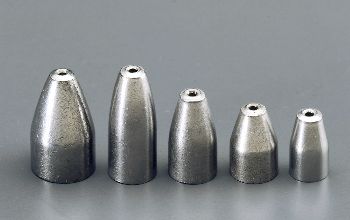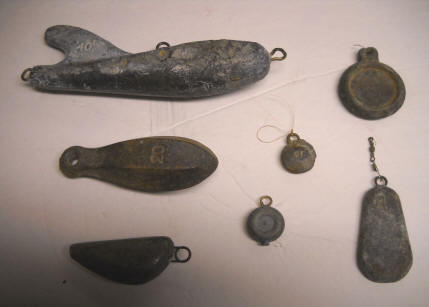 |
Which Sinker to Use ? |
|
Definition ; Sinkers and weights are some of the most important pieces of terminal tackle in fishing. You may ask "What is the real difference between a sinker and a weight?". Generally these two terms are used interchangeably when it comes to fishing.
Here, I will try to give examples of different sinkers, their intended or normal usage and how they can be rigged.
Probably the first fishing weight, would have simply been a rock. Anything heavy enough to do the job has been used, from used railroad spikes to old spark plugs. However to do the job effectively while creating least resistance, the heaviest common metal that has been around for a while is lead. This metal melts at a relatively low temperature, allowing simple moulds to be made, facilitating casting of different styles, shapes and weights.
However in recent years the environmentalists are pushing for eliminating these lead fishing sinkers because they firmly believe lost lead sinkers are polluting our environment and threatening extinction of some birds. But that is another story.
Other than dry fly fishing, most fishermen use a weight to lower their lure to the anticipated water depth of a targeted fish. There are also many styles and innumerable shapes which have been perfected for diverse fishing applications.
Possibly a good place to numerous styles of sinkers is go to Cabelas website sinker page http://www.cabelas.com/weights.shtml
Sinkers Themselves ; Like mentioned above, a simple rock which could have had a groove etched around it to allow a cord to be secured to it could have been the first. In the United States, most sinkers will have the size in ounces or fractions of an ounce. Below that the size will be like the round slit shot and may be sized as BBs.
|
egg sinkers |
rubber core sinkers |
split shot with ears, sometimes called reusable |
|
|
|
|
Shown in the photo below are typical sinker sliders. The upper LH rig is simply a section of greenhouse watering tubing that is cut at an angle on the top with a hole burned in it using a match and paper clip. Into the tubing is inserted a section of 3/16" pencil lead. If the lead hangs up, it just pulls out of the tubing. This is typically used for drift fishing for Steelhead.
To the right top is a commercial sinker slider but a plastic bead with a Golf Tee beening slid over the mainline. This Golf Tee helps divert any weeds off the swivel if you happen to be fishing weed/debris infested waters. Below this is basically the same but made up using just barrel swivels and snaps. The bead is placed there as a bumper for the sinker against the knot to protect the knot. These 2 can be used with the cannonball attached directly to the slider snap because these style of snaps are the weakest whereas the snap will fail (maybe not by design, but that is how it seems to work) before you break the mainline. The bottom left again uses a commercially made Nylon slider, but the snap is stronger, so in this instance you would attach a sinker by means of a short lighter mono to the snap. You can also simply use a barrel swivel with the mainline ran thru one eye and the other to a sinker.
All the above work well if you are using barbless hooks as when the fish runs the sinker is not close to your terminal gear but slides on the mainline so the fish does not have the advantage of using the weight of the sinker to throw the hook. Or if you are plunk fishing where you do not want the fish to feel the pull on the sinker when they are mouthing the bait before they decide to take it.
|
Sinker sliders |
|
|
In the photo below are representatives of sinkers used for trolling. All of these are the same 6 ounce size, just the shape and method of attaching are different.
On the left is a old style sinker known as a split ring slider. It was one of the first trolling sinkers, Next are 6 ounce kidney or, crescent type, at times called "mooching" sinkers, & a 6 ounce cannonball sinker on the right. The two kidney sinkers even though are the same weight, you will notice are slightly different thickness. This is because the upper one (a US made) is also made in a slight teardrop section supposedly to create less drag, while the bottom sinker had a tag (made in Taiwan), it is made in basically a round cross section.
The split ring sinker has a brass wire made into 2 loops, which allowed the sinker to be positioned onto or off the mainline by placing the mainline under the wire, rotating the sinker until the mainline was trapped inside. The was then positioned laterally where it was wanted on the mainline which was then pulled down into a double coiled wire in the rear to retain it until a salmon was hooked, which pulled the mainline loose allowing the sinker to slide free on the mainline. This double clip was made of the same brass wire as the loops & was made similar to a large split ring.
The kidney sinkers utilize a bead-chain swivel on the rear to eliminate twisting of a normal 6' mono mooching leader . The front barrel swivel also helped the sinker from rotating along with providing a convenient eye to attach a mainline to. Their normal salmon mooching size is from 2 ounce up to 8 ounces.
The cannonball sinker simply has a brass eye in the top. It can be attached to a 3 way swivel at the end of the mainline or attached to a slider swivel or sturgeon style slider (seen above)that utilizes a snap for the sinker attachment onto the mainline. The cannonball has somewhat replaced the kidney sinker for mooching, because of the requirement for barbless hooks, this sinker being attached to the mainline by a slider, it pretty well eliminates the chance of the fish to use the weight to throw the hook when it shakes it's head or makes numerous jumps or rolls.
| sinkers & a cannonball sinkerHere is a old style line slip sinker, kidney mooching |
|
|
Possibly the smallest type sinker could be construed to be in the form of a leaded line. This could be found in a sinking fly-line or a trolling line where a small ribbon of lead is woven into the core of the line.
Freshwater fishing has a multitude
of different styles, bass fishing has developed their own as has walleye and
steelhead.
Bass fishermen sometimes use what is known a Texas or Carolina rigs. These
use a sliding bullet nose sinker made of lead, brass or steel. Both use
basically the same rigging with slight differences, but in essence, they slide
the weight on the mainline, then attach a snag-proof hook that allows the front
of the worm (either live or plastic) to be pulled close to the weight.
| Bullet nose sinkers |
 |
The bottom bouncers (also known as bottom walkers) seem to have been developed for Walleye, these have a single wire molded inside the lead weight. They come in different weights and on some, these weights can be interchanged. Colors can vary. The wire (about 10") runs thru this weight then extends farther down intended to drag the bottom. In doing so this maintains the lure which is attached to the shorter arm to the rear off the bottom near the feeding fish also out of rocks or allowing it to climb over underwater limbs or debris. This works great also for trolling for salmon in rivers near or just above tidewater where there is a lot of dead logs or trees in the water and can save you hung up/ lost gear.
| Walleye bottom walker |
|
|
Steelhead tackle many times will be casting and drifting with either weights near the bottom or under a bobber. This style of fishing uses sinkers for many years have been a chunk cut off a spool of 3/16" or 1/4" pencil, lead attached to a 3 way or slider swivel by means of a short piece of surgical tubing. In use, if the lead gets hung, it simply is pulled enough to come out of the tubing. Recent years basically the same is used but is in the form of "slinkies" which is a section of thin hollow Nylon braided tubing that buckshot is inserted into and the ends heat seared to retain the lead.
Illustrated below are lead sinkers used for fishing where the weight rests on the bottom. You will notice the different shapes, but they all are designed to pretty well stay where they were placed and not moved by water/wave motion or at least a location later being drug to by the fisherman. These can be found in numerous sizes from 1/4 of an ounce up to usually 10 ounces, depending on the intended purpose.
Shown below are a 10 ounce pyramid sinker on the left, a 4 ounce bank sinker, a 8 ounce pancake sinker, and a 10 ounce disc sinker. On the right are sand or claw type sinkers
| Shown here are heavier sinkers normally used for ocean surf fishing or estuary fishing for sturgeon | Claw type sinker |
|
|
|
Reminiscing of the Old Days ; If these items could only talk, a book could be written.
 |
 |
This Page Under Construction
Copyright © 2011 - 2023 LeeRoy Wisner All Rights Reserved
Back to the
Ramblings Home Page
Originated 02-21-2011 Last updated
08-17-2023
Contact the author
http://www.perkons1.com/SANDSINKERS/Sandsinkers.html